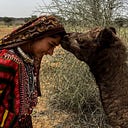‘This is living to me’: The women swapping city life for shepherding in the Pyrenees
Source: The Guardian
Photographer Paroma Basu followed three young Spanish women who have left urban careers and retrained through the Escola de Pastors i Pastores de Catalunya, one of a number of ́herding schools opening around Spain
A head for quick thinking is required in the outdoors, where conditions can rapidly change, so shepherds need to always remain alert. Having graduated from shepherd school, Guzman Mejias wants to travel this year to observe pastoral workers in other countries.

Amanda Guzman Mejias briefly worked in marketing in Barcelona before realising she hated office and city life. When she heard about shepherding school, Guzman Mejias immediately applied and has never looked back. ‘It is like I have found my way,’ she says.

Xisqueta sheep grazing at the top of Mount Bonaigua. The Xisqueta are a hardy, rugged breed, native to the Catalan Pyrenees. A few decades ago they were listed as endangered, but in recent years numbers have recovered.

Guzman Mejias, with the striped umbrella, and Vicky Garcia, 25, look after 400 sheep and goats at high altitudes. Herds are moved to cooler, higher pastures during the hot summer months. In early autumn, the animals come back down to the plains.

One of the oldest domesticated animals, goats are adventurous eaters with robust stomachs to match. They can navigate terrain inaccessible to other animals and are useful in fire prevention because they clear flammable brush and vegetation.

Gaucha, Lizarza Solana’s 18-month-old sheepdog, discovers a newborn lamb that was accidentally left behind when its mother gave birth while grazing in the forest.

Every day, Lizarza Solana walks her hungry herd for up to eight hours, as they seek out fresh vegetation to fill their bellies. ‘I am feeling very healthy because I am walking all day,’ she says. ‘I think it’s good for the body and mind to live like this.’

Heatwave sparked an unprecedented number of wildfires in Spain last year, aggravated by rising temperatures from global heating. Sheep and goats have been deployed for centuries to clear the land of excess vegetation, and a growing number of countries are embracing them as an important method of fire prevention.

Espina Calatayud’s day begins with a four-hour hike through the forests with the goats. Once they are milked, they set off on another four-hour hike, usually returning after dark. ‘This is a way of life and not only a job,’ she says.
